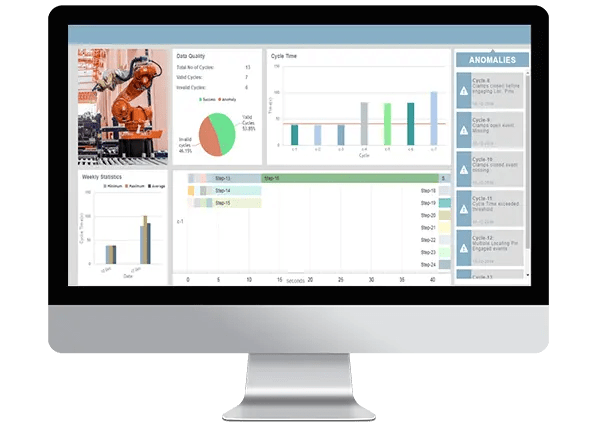Digital Transformation and Engineering
- Mon-Sat 8.00 - 20.00
- (+84) 976-099-099
INDUSTRIAL AUTOMATION USING IOT
Industrial Automation and Analytics
Intelligent Digital automation of Industrial Processes helps in optimizing cost and increasing efficiency. Manufacturing Industries rely heavily on robots programmed to perform a specific task like holding a metallic panel in pace while another robot operates on the panel. Usage of more robots increases the safety of human operators while improving the overall quality of the final product.

Let’s take the use case of a Turn table robot that shapes the metallic hood panel which is used to build the body of automotive vehicles. Typically, the metallic is kept in place by using pneumatic cylinder pistons which Open and close a Mechanical Clamp. The pneumatic pistons are controlled electrically via Timer circuits. Only when the clamps holding the metallic panel in place, the Turn table robots will be able to operate and shape the hood. IoT sensors can be installed along with a Gateway to capture data related to every event and then such data can be used to generate useful analytics.
Typical steps of a turntable operating robot:
- The Turntable robot operates on a hood and once finished, the Locating Pins which are used the identify the dimensions of the placed Hood along with the Gripper are disengaged.
- All the Clamps which were holding the panel in place are now opened. The Turntable operator then removes the hood panel.
- Once the panel is removed, the Locating Pins again go engaged. The Turntable operator then places a new metallic hood that needs to be operated. The Locating pins identify the dimensions and the Gripper is Locked.
- Once the Gripper is locked, all the Pistons go high causing the Clamp to latch on to the panel by keeping it in place while the Turntable robot starts operating on the hood.
- The cycle repeats and ideally, it takes around 1 minute 30 seconds to operate on one metallic hood.
We integrated AWS Cloud into this manufacturing process by capturing the data of the Turntable robot, Clamps, Locating Pins and Gripper events (Going High or Low) using IoT Sensors attached to the mechanical parts. This data was then transmitted to Cloud. We then process the data as follows:
- Group the stream of events with a timestamp into an Operational Turntable cycle consisting of the steps mentioned above.
- Identify any anomalies while grouping the events like if any events missing in a full cycle or if any event like the Clamps or Gripper taking longer to get engaged. This increases the wait time for Turntable robot reducing operational efficiency.
- Calculate the overall Cycle time for each hood being operated by the robot and compare the time against an ideal benchmark duration flagging long running cycles.
- Drill down of each operational cycle into its individual steps highlighting which event took more time.
- Capture Daily Cycle quality showing Production cycles within Baseline duration and Cycles deviating from the ideal duration.
- Weekly statistics with Minimum, Maximum and Average Production Cycle durations.
Subscribe
Get the latest tips, software updates and promos.

